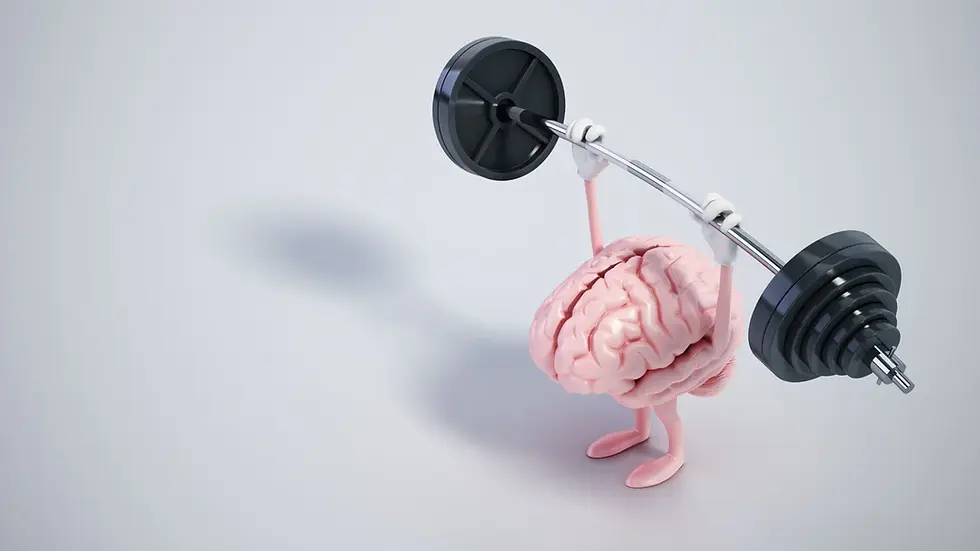Neurofeedback training for cognitive decline and dementia
- Rachel Langford

- Feb 3, 2022
- 3 min read
The ability to focus attention, encode and maintain information are among the brain’s most important cognitive functions. Attention is a central component of cognitive ability. Measurements of neural activity have become strong predictors of cognitive impairments in persons afflicted with various kinds of cognitive deficits. Lapses in attention can impair memory and behavioural performance.
Complaints about declined attention and memory are common in healthy and cognitively intact older adults during brain aging. Deficits in attention and memory are also the most common symptoms in older adults with dementia such as Alzheimer’s disease (AD), Parkinson’s, or vascular dementia (VD). Old-age dementia affects patients’ daily lives with memory loss and cognitive impairments. The most common early symptoms of AD are problems with short-term memory (Reiman et al., 2011). Since there is no effective drug treatment thus far to stop cognitive decline, attention training has become an increasingly attractive option. The effectiveness of cognitive rehabilitation including attention training has been under debate for decades. A recent review has shown evidence that attention training enhances attention and memory with moderate success (Cicerone et al., 2011). Since attention is a core function for multitude of cognitive processes (e.g., memory and perception), most cognitive training (CT) programs seek to increase the existing attentional capacity.

Rationale for Using Neurofeedback in the Treatment of Dementia
Although being a relatively new field, preliminary studies with healthy participants and different clinical populations suggest that neurofeedback training may be effective to improve brain function, treat cognitive as well as affective symptoms and induce brain plasticity (Arns et al., 2017; Sitaram et al., 2017; Thibault et al., 2018). Therefore, neurofeedback training has been suggested as a potential complementary treatment for patients suffering from dementia.
Cognitive decline is a defining feature of dementia. Neurofeedback training combines cognitive training with operant conditioning of the associated neural substrate, e.g., attention or memory recall (Sitaram et al., 2017). For instance, working memory and attention share common neural mechanisms, which can be trained through top-down cognitive strategies (Cicerone et al., 2011; Gazzaley and Nobre, 2012), leading to performance improvements (Karbach and Verhaeghen, 2014). Thus, neurofeedback-based cognitive training may provide an attractive complimentary treatment for patients suffering from different forms of dementia (Jiang et al., 2017). For example, in experiments with healthy elderly participants, EEG-based neurofeedback training led to improved performance in different cognitive domains (Angelakis et al., 2007; Keizer et al., 2010; Lecomte and Juhel, 2011; Becerra et al., 2012; Wang and Hsieh, 2013; Reis et al., 2016; da Paz et al., 2018).
Patients with dementia experience psychological symptoms as well as cognitive ones
Besides cognitive decline, it is known that more than 70% of patients with dementia experience psychological symptoms, such as anxiety, depression, or apathy (Lyketsos and Lee, 2004; Craig et al., 2005; Steffens et al., 2005). Different neurofeedback protocols were able to target brain areas and networks responsible for emotion processing (Johnston et al., 2010; Linhartová et al., 2019), which opens the possibility of applying this method to treat psychological symptoms in patients suffering from dementia (Kim and Birbaumer, 2014; Arns et al., 2017). For example, randomized controlled trials (RCTs) of fMRI-based neurofeedback training reported improvement of depressive symptoms in patients with major depressive disorder (Young et al., 2017; Mehler et al., 2018) and anxiety symptoms in patients with obsessive-compulsive disorder (Scheinost et al., 2014). For instance, in experiments with older adults, fMRI- and EEG-based neurofeedback training was associated with improved recognition of emotionally valent faces (Rana et al., 2016) and reduced depressive symptoms (Ramirez et al., 2015), respectively.
Patients with dementia present specific neural signatures that correlate with their symptoms
As previously mentioned, patients with dementia present specific neural signatures that correlate with their symptoms. For example, patients with MCI and AD present altered EEG frequencies (Cassani et al., 2018) and abnormal fMRI functional connectivity at rest (Jacobs et al., 2013; Badhwar et al., 2017). These correlates may provide biomarkers, and their predictive potential as well as validity can be tested by using these as treatment targets (Mehler and Kording, 2018; Micoulaud-Franchi et al., 2019). Similar to brain stimulation protocols, neurofeedback protocols aim to modulate local activity (Linden, 2014). However, since neurofeedback acts as an “endogenous” stimulation, it reduces safety risks or side effects associated with other approaches, such as non-invasive transcranial stimulation or invasive deep brain stimulation. Specifically, it is hypothesized that training participants to regulate biomarkers, it may be possible to induce cognitive improvements, stimulating residual neural plasticity that is maintained to some degree despite dementia (Mirmiran et al., 1996; Prichep, 2007).
This information is taken from the following publications;
Attention and working memory training in the aging brain, as well as review about neurofeedback in AD cases can be found in the following review: https://www.ncbi.nlm.nih.gov/pmc/articles/PMC5346575/
Neurofeedback and the Aging Brain: A Systematic Review of Training Protocols for Dementia and Mild Cognitive Impairment: https://www.ncbi.nlm.nih.gov/pmc/articles/PMC8221422/









Comments